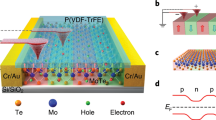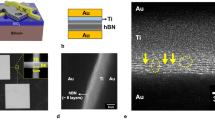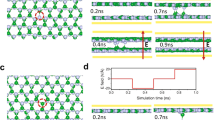Abstract
Electric-field-controlled electronic and structural phase transitions can be used as a mechanism for memristive switching in two-dimensional (2D) materials. However, such 2D phase-change memristors do not typically outperform other 2D memristors. Here we report high-performance bipolar phase-change memristors that are based on strain-engineered multilayer molybdenum ditelluride (MoTe2). Using process-induced strain engineering, stressed metal thin films are patterned into contacts that induce a strain-driven semimetallic-to-semiconducting phase transition in the MoTe2, forming a self-aligned vertical transport memristor with semiconducting MoTe2 as the active region. By using strain to bring the material close to the phase transition boundary, the devices can exhibit switching voltages of 90 mV, on/off ratios of 108, switching times of 5 ns and retentions of over 105 s. A single-process parameter, contact metal film force (the product of the film stress and film thickness), can be varied to tune the device switching voltage and on/off ratio.
This is a preview of subscription content, access via your institution
Access options
Access Nature and 54 other Nature Portfolio journals
Get Nature+, our best-value online-access subscription
$29.99 / 30 days
cancel any time
Subscribe to this journal
Receive 12 digital issues and online access to articles
$119.00 per year
only $9.92 per issue
Buy this article
- Purchase on Springer Link
- Instant access to full article PDF
Prices may be subject to local taxes which are calculated during checkout






Similar content being viewed by others
Data availability
Source data are provided with this paper. All other data that support the findings of this study are available from the corresponding author upon reasonable request.
References
Chua, L. Memristor-the missing circuit element. IEEE Trans. Circuit Theory 18, 507–519 (1971).
Strukov, D. B., Snider, G. S., Stewart, D. R. & Williams, R. S. The missing memristor found. Nature 453, 80–83 (2008).
Xia, Q. F. & Yang, J. J. Memristive crossbar arrays for brain-inspired computing. Nat. Mater. 18, 309–323 (2019).
Yang, J. J. S., Strukov, D. B. & Stewart, D. R. Memristive devices for computing. Nat. Nanotechnol. 8, 13–24 (2013).
Duan, H. et al. Low-power memristor based on two-dimensional materials. J. Phys. Chem. Lett. 13, 7130–7138 (2022).
Huh, W., Lee, D. & Lee, C. H. Memristors based on 2D materials as an artificial synapse for neuromorphic electronics. Adv. Mater. 32, 2002092 (2020).
Qian, K. et al. Hexagonal boron nitride thin film for flexible resistive memory applications. Adv. Funct. Mater. 26, 2176–2184 (2016).
Zhao, H. et al. Atomically thin femtojoule memristive device. Adv. Mater. 29, 1703232 (2017).
Kim, M. et al. Zero-static power radio-frequency switches based on MoS2 atomristors. Nat. Commun. 9, 2524 (2018).
Wu, X. H. et al. Thinnest nonvolatile memory based on monolayer h-BN. Adv. Mater. 31, 1806790 (2019).
Xu, R. J. et al. Vertical MoS2 double-layer memristor with electrochemical metallization as an atomic-scale synapse with switching thresholds approaching 100 mV. Nano Lett. 19, 2411–2417 (2019).
Zhang, F. et al. Electric-field induced structural transition in vertical MoTe2- and Mo1-xWxTe2-based resistive memories. Nat. Mater. 18, 55–61 (2019).
Chen, S. C. et al. Wafer-scale integration of two-dimensional materials in high-density memristive crossbar arrays for artificial neural networks. Nat. Electron. 3, 638–645 (2020).
Li, Y. S. et al. Anomalous resistive switching in memristors based on two-dimensional palladium diselenide using heterophase grain boundaries. Nat. Electron. 4, 348–356 (2021).
Liu, L. et al. Low-Power memristive logic device enabled by controllable oxidation of 2D HfSe2 for In-Memory computing. Adv. Sci. 8, 2005038 (2021).
Lei, P. X. et al. High-performance memristor based on 2D Layered BiOI nanosheet for low-power artificial optoelectronic synapses. Adv. Funct. Mater. 32, 2201276 (2022).
Pam, M. E. et al. Interface-modulated resistive switching in mo-irradiated res2 for neuromorphic computing. Adv. Mater. 34, 2202722 (2022).
Yin, L. et al. High-performance memristors based on ultrathin 2D copper chalcogenides. Adv. Mater. 34, 2108313 (2022).
Zhang, X. L. et al. Tunable resistive switching in 2D MXene Ti3C2 nanosheets for non-volatile memory and neuromorphic computing. ACS Appl. Mater. Interfaces 14, 44614–44621 (2022).
Zhang, F. et al. An ultra-fast multi-level MoTe2-based RRAM. In IEEE Int. Electron Devices Meet. 22, 22.7.1–22.7.4 (IEEE, 2018).
Duerloo, K. A. N., Li, Y. & Reed, E. J. Structural phase transitions in two-dimensional Mo- and W-dichalcogenide monolayers. Nat. Commun. 5, 4214 (2014).
Orain, S., Fiori, V., Villanueva, D., Dray, A. & Ortolland, C. Method for managing the stress due to the strained nitride capping layer in MOS transistors. IEEE Trans. Electron Devices 54, 814–821 (2007).
Thompson, S. E., Sun, G. Y., Choi, Y. S. & Nishida, T. Uniaxial-process-induced strained-Si: extending the CMOS roadmap. IEEE Trans. Electron Devices 53, 1010–1020 (2006).
Hou, W. et al. Strain-based room-temperature non-volatile MoTe2 ferroelectric phase change transistor. Nat. Nanotechnol. 14, 668–673 (2019).
Azizimanesh, A., Pena, T., Sewaket, A., Hou, W. H. & Wu, S. M. Uniaxial and biaxial strain engineering in 2D MoS2 with lithographically patterned thin film stressors. Appl. Phys. Lett. 118, 213104 (2021).
Pena, T. et al. Strain engineering 2D MoS2 with thin film stress capping layers. 2D Mater. 8, 045001 (2021).
Pena, T. et al. Temperature and time stability of process-induced strain engineering on 2D materials. J. Appl. Phys. 131, 024304 (2022).
Chowdhury, S. A. et al. Mechanical properties and strain transfer behavior of molybdenum ditelluride (MoTe2) thin films. J. Eng. Mater. Technol. 144, 011006 (2022).
Hou, W. H. et al. Nonvolatile ferroelastic strain from flexoelectric internal bias engineering. Phys. Rev. Appl. 17, 024013 (2022).
Wang, J. Y. et al. Determination of crystal axes in semimetallic T’-MoTe2 by polarized Raman spectroscopy. Adv. Funct. Mater. 27, 1604799 (2017).
Kan, M., Nam, H. G., Lee, Y. H. & Sun, Q. Phase stability and Raman vibration of the molybdenum ditelluride (MoTe2) monolayer. Phys. Chem. Chem. Phys. 17, 14866–14871 (2015).
Zhang, Y. J. et al. Mechanical properties of 1T-, 1T ‘-, and 1H-MX2 monolayers and their 1H/1T ‘-MX2 (M = Mo, W and X = S, Se, Te) heterostructures. AIP Adv. 9, 125208 (2019).
Kim, S. et al. Stochastic stress jumps due to soliton dynamics in two-dimensional van der waals interfaces. Nano Lett. 20, 1201–1207 (2020).
Kumar, H., Dong, L. & Shenoy, V. B. Limits of coherency and strain transfer in flexible 2D van der Waals heterostructures: formation of strain solitons and interlayer debonding. Sci Rep. 6, 21516 (2016).
Lanza, M. et al. Recommended methods to study resistive switching devices. Adv. Electron. Mater. 5, 1800143 (2019).
Lanza, M., Molas, G. & Naveh, I. The gap between academia and industry in resistive switching research. Nat. Electron. 6, 260–263 (2023).
Yang, J. J. et al. High switching endurance in TaOx memristive devices. Appl. Phys. Lett. 97, 232102 (2010).
Lee, M. J. et al. A fast, high-endurance and scalable non-volatile memory device made from asymmetric Ta2O5-x/TaO2-x bilayer structures. Nat. Mater. 10, 625–630 (2011).
Raoux, S., Welnic, W. & Ielmini, D. Phase change materials and their application to nonvolatile memories. Chem. Rev. 110, 240–267 (2010).
Pena, T., Holt, J., Sewaket, A. & Wu, S. M. Ultrasonic delamination based adhesion testing for high-throughput assembly of van der Waals heterostructures. J. Appl. Phys. 132, 225302 (2022).
Scandolo, S. et al. First-principles codes for computational crystallography in the Quantum-ESPRESSO package. Z. Kristallogr. 220, 574–579 (2005).
Perdew, J. P., Burke, K. & Ernzerhof, M. Generalized gradient approximation made simple. Phys. Rev. Lett. 77, 3865–3868 (1996).
Sun, Y. F. et al. Low-temperature solution synthesis of few-Layer 1T’-MoTe2 nanostructures exhibiting lattice compression. Angew. Chem. Int. Ed. 55, 2830–2834 (2016).
Acknowledgements
S.M.W. acknowledges support from the National Science Foundation (OMA-1936250 and ECCS-1942815). Raman spectroscopy was performed at the Cornell Center for Materials Research Shared Facilities (CCMR), and CCMR is supported through the NSF MRSEC Program (No. DMR-1719875). We would like to thank Qiang Lin at the University of Rochester in aiding us with the equipment that made it possible to obtain switching speed test results.
Author information
Authors and Affiliations
Contributions
The device fabrication was performed by W.H. and A.A. and the device characterization was performed by W.H., Y.Y. and C.S. Raman spectroscopy was performed by A.A. Thin film stress measurements were performed by W.H. and A.A. The density functional theory simulation of the strain phase diagram was performed by A.D. and supervised by H.A. and S.S. High-speed pulse testing was performed by W.H. and W.W., and supervised by H.W. Figure rendering was performed by W.H. and the paper was written by W.H., A.A. and S.M.W. Original experiment conception and project supervision was provided by S.M.W.
Corresponding author
Ethics declarations
Competing interests
The authors declare no competing interests.
Peer review
Peer review information
Nature Electronics thanks Ning Dai, Jianhua Hao and Huairuo Zhang for their contribution to the peer review of this work.
Additional information
Publisher’s note Springer Nature remains neutral with regard to jurisdictional claims in published maps and institutional affiliations.
Supplementary information
Supplementary Information
Supplementary Figs. 1–20, Discussion and Table 1.
Source data
Source Data Figs. 1–6
Raw data for main text Figs. 1–6.
Rights and permissions
Springer Nature or its licensor (e.g. a society or other partner) holds exclusive rights to this article under a publishing agreement with the author(s) or other rightsholder(s); author self-archiving of the accepted manuscript version of this article is solely governed by the terms of such publishing agreement and applicable law.
About this article
Cite this article
Hou, W., Azizimanesh, A., Dey, A. et al. Strain engineering of vertical molybdenum ditelluride phase-change memristors. Nat Electron 7, 8–16 (2024). https://doi.org/10.1038/s41928-023-01071-2
Received:
Accepted:
Published:
Issue Date:
DOI: https://doi.org/10.1038/s41928-023-01071-2



